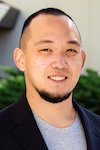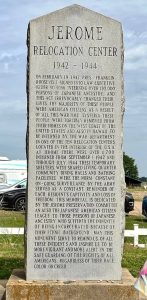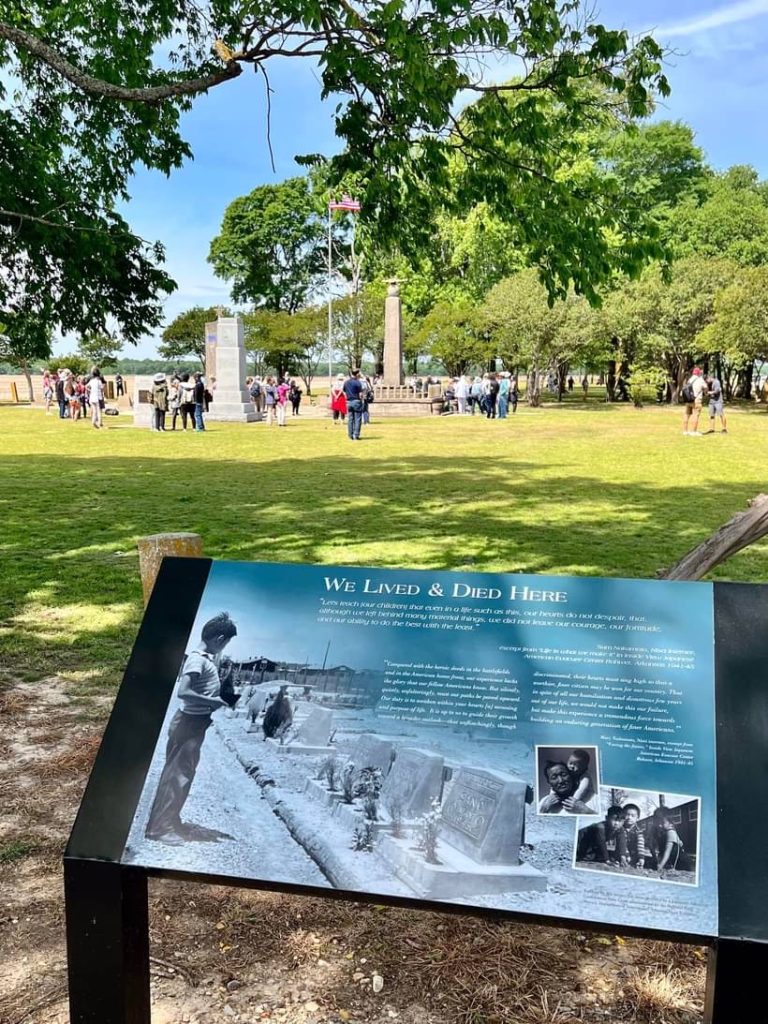
Michael Tanaka
In early May, I had the privilege of embarking on a four-day pilgrimage to Little Rock, Ark., where I stepped on the same grounds as seven members of my family who were imprisoned at Jerome and Rohwer incarceration camp 81 years ago, thanks to Kimiko Marr and the Japanese American Memorial Pilgrimages.
While I went by myself, not once throughout the pilgrimage did I feel alone. There is a sincere, unspoken form of solidarity meeting people in the very place our families were once incarcerated that is powerful and comforting.
In trying to connect the dots of a history that was never explained to me, I realized this pilgrimage was as much about picking up the pieces of my own family’s story, as it was uncovering and uplifting the other 16,000 other stories that need to be honored, too.

The Jerome memorial is the only remnant remaining of the former American concentration camp. (Photo: Courtesy of Rick Kanazawa)
Learning about incarceration to resettlement, and the diaspora that followed, this pilgrimage proved to me that the story of Japanese American incarceration is the most defining part of my Yonsei-Gosei identity.
After going on this pilgrimage and working for the JACL there are two thoughts that constantly ring in my head: What are the forces that shape this community? What are the forces that divide this community?
Learning how Japanese American sentiment in Arkansas changed from families being denied resettlement to being granted the freedoms and privileges of being “White” in the segregated South, I question why Japanese Americans were conditionally “accepted” in this case, but in places like California where my grandparents returned from Jerome, racial covenants greatly limited where they could live and work.
I question to what degree the effects of incarceration and prejudice were instilled into the way Japanese Americans built community, treated each other and held onto their past as a matter of shame. I question why my grandparents never spoke about their incarceration history, and why my parents never sought to learn it.
I grew up in the largest concentration of Japanese Americans with incarceration history in the country, but the cultural and social institutions that raised me prioritized social activities such as basketball. Is there a reason behind this, or is this just an excuse?
Personally, I don’t think it’s either. Just because something is ignored or not taught doesn’t mean it’s not relevant. In fact, if incarceration isn’t relevant to my generation, why do we continue to exclude people without incarceration history? I question the irony of a community born out of exclusion, being exclusive. Is this just internalized trauma?

The Rohwer Cemetery (Photo: Courtesy of Rick Kanazawa)
It all boils down to the same questions. Nevertheless, after going on this pilgrimage, for all the thoughts I have, I am grateful for the people I met along the way.
I’m thankful to the Asaki family and Erin Shigaki for taking me in and adopting me as their “cousin.”
I’m thankful for Tom Kurihara, Hach Yasumura, Masako Guthrie, Lois Lepekas, George Teraoka and all the Nisei for their presence and wisdom. I’m thankful for Julie Abo and our intergenerational discussion group for bringing a deeper perspective to the ways Nisei, Sansei and Yonsei-Gosei experience this pilgrimage and interpret the effects of our incarceration histories. I’m thankful for Kimiko Marr and her team for the sacrifices they made to create this life-changing experience.
Collectively, they taught me that just because I don’t have all the answers, it doesn’t mean that I should give up on trying to find them.
For all the work that needs to be done, I know it is not too late. In fact, I am hopeful I am right on time.
Michael Tanaka is JACL’s Daniel K. Inouye Fellow. He is based in the organization’s Washington, D.C., office.



